Surprisingly SPEED’s Formula 1 anchor Bob Varsha was never a car enthusiast, race car driver, designer, engineer or mechanic: he graduated from law school and his first love was cross country running. Yet for over 20 years Varsha has reported on our favorite sport with great enthusiasm, in-depth knowledge and professionalism far above par. Unflappable, with a magnetic memory and smooth, even, assured delivery, he is an anchor’s anchor, rising above the noise and screams and conjecture whether at BJ Auctions or a Formula 1 race. It would be hard to imagine watching a Formula 1 event without Varsha at the helm.
Varsha grew up in Northport, New York, thinking he might be happy as a small town lawyer. He attended Dartmouth College in New Hampshire, then went south to Emory School of Law in Atlanta, where he graduated in 1977. His interest in sports and cross country running led him to participate in marathons. After law school, Varsha was asked to help organize the Peachtree Road Race running event. That led to an entrée into TV, as one day CNN called and asked if he would help televise the Peachtree event. That went well despite his long hair, mustache and a checkerboard three-piece suit. CNN called a few weeks later to offer Varsha a job doing overnight news watches, and later he did CNN morning news on radio. Then CNN Sports called, and he did a series called Motorweek Illustrated. After four years with Turner, he covered IMSA racing at ESPN for a decade, then on to Speed in 1999.
David Seibert is well known to Ferrari race fans and VeloceToday readers, having been in charge of the U.S. Ferrari Historics for many years. A long-time friend of Varsha’s, Seibert conducted this exclusive two-part VeloceToday interview with the dean of Formula 1 broadcasters.
Interview by David Seibert, Interview photos by Sidell Tilghman
VeloceToday: Why are you the only American on the F1 SPEED team?
(Laughing…) There’s no deliberate attempt to make it that way. Back when SPEED got into F1, David Hobbs seemed a logical candidate, and his old sparring partner Sam Posey came along. Our F1 Producer at the time, Frank Wilson, was looking for something different, maybe from an F1 mechanic’s perspective. He had read Steve Matchett’s book on F1, so he gave him a call and Steve was able to join the team. I arrived in 1999. We all got along extremely well, but when we moved from Connecticut to Charlotte, Sam chose to stay home in Connecticut. So it became Hobbs, Matchett and I. Sam still does the lead in for us… he is one of the most intelligent men in TV and it shows. It was just happenstance that both Hobbs and Matchett, and then Peter Windsor and now Will Buxton, are British.
VeloceToday: Take us to the Studio on a typical Formula 1 race weekend.
Typically, on an F1 weekend David, Steve and I all meet in Charlotte, N.C. on Thursday. We show up at the studios a few hours before the broadcast, and because it’s live, the time varies depending on where the race is being held. Before the event we do our individual preparations: Matchett talks to his engineering contacts and friends; Hobbs may bounce things off guys like Brian Redman, Jackie Stewart and some journalists, and I’m on the Internet every day checking the F1 sites for news and the latest information. I’ll compile about a ten page dossier of talking points for Dave, Steve and myself to review. We usually have a production meeting and talk via phone with Will Buxton on site before the event. On Friday morning we’ll do the second practice live, then tape the “F1 Debrief” show covering the previous race.
Saturday we cover qualifying and then segue into recording the first GP2 race of the weekend. We handle qualifying slightly differently from practice or the race itself. Because of the three-session knockout format, which starts at the top of the hour, we back up the coverage about ten minutes in order to get on the air sensibly—so it is not actually live. This drives some viewers nuts, as they are right there with their computers watching the lap times, and yet the SPEED broadcast has some delay. This is so we can maximize the on-track time without losing commercial breaks. Often the segments catch up with the live broadcast anyway, and we are suddenly in synch with the live action.
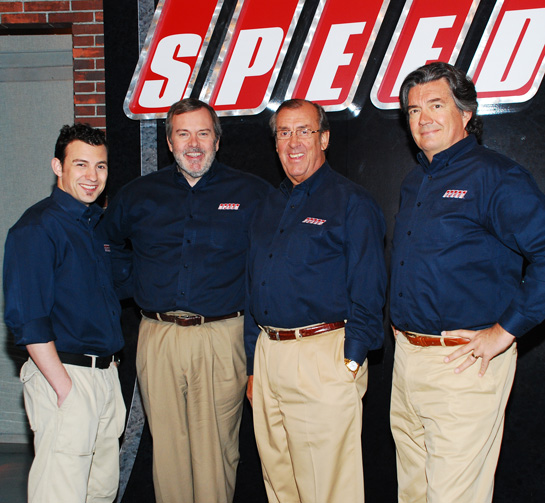
The SPEED team poses for the cameras. From left, Will Buxton, Steve Matchett, David Hobbs and Bob Varsha. Credit SPEED
On race day we arrive early to complete the GP2 broadcast with highlights of the second race, and then get ready for the F1 show. Each day we also wrap with a short commentary round table for SPEED.com, Steve records his Chalk Talk tech piece on Fridays, and I typically return Sunday for a segment on our Speed Center highlight show, formerly called The Speed Report. I might also join Dave Despain on Wind Tunnel, so F1 weekends often result in 15-16 hour days on Sunday for me.
Qualifying, practice and the race are all very different and each is enjoyable. Practice is laid back; Saturday is much more tense, as it is all about the grid qualifying. And the race is all about the spectacle.
As a commentator, I try to appeal to wide variety of viewers. Some people know nothing about the sport and want to be educated, others know more about F1 than we do and are waiting for us to tell them something they didn’t already know. The real challenge for our team is to give all viewers out there what they want.
VeloceToday: How to you catch so many details during the race?
I’d like to say it is due to our combined experience, but we actually just get lucky sometimes. It helps to have a lot of eyeballs on the screens; Steve is watching from his viewpoint, and Dave is watching the race from his perspective. Steve looks for mechanicals, David is looking at what the drivers see, while I’m looking for the “gee wiz” perspective. This year we are going to High Definition TV for the first time, so hopefully we’ll be able to pick up on a lot more of those details.
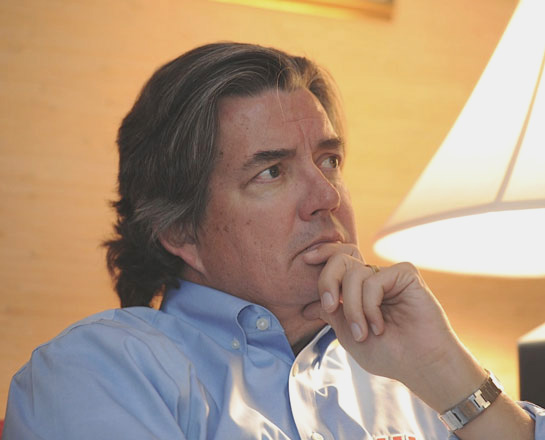
I try to appeal to wide variety of viewers. Some people know nothing about the sport and want to be educated, others know more about F1 than we do and are waiting for us to tell them something they didn’t already know. The real challenge for our team is to give all viewers out there what they want. Credit Sidell Tilghman
VeloceToday: How many screens do you have in the studio?
There are maybe seven large screens in front of us. Steve sits on the far left, and while David and I are looking at the race, he concentrates on the mechanical and technical details with the help of his own producer and monitor. We have four central monitors that show the incoming feed from the site, the program feed which is what is being sent out to our viewers, two large screens that show the official F1 timing and scoring, and a network return feed, or what the folks are seeing at home, including the commercials. The producer also has a special screen to send out a message called an isolation monitor. With it he can show me something off-line; it may be a graphic, replay historical footage, interview or whatever. He’ll say, “Bob, watch your iso monitor while David is doing the track bit, I want to incorporate this later.” I don’t know how many screens that adds up to, but it’s a nice glow in the studio!
VeloceToday: How do you come up with all those statistics during the broadcast?
Oh yes, I almost forgot. We also have a ‘stat’ monitor and a guy named Sean Kelly. He’s been an F1 fan his entire life. Sean lives in San Diego, a Brit by birth, and has a company called “Virtual Statman”. He is usually with us during an F1 event, giving us information such as how many races Sebastian Vettel has won. He will also prepare a 25 page dossier about the country, race results, driver by driver stats, history of the race, and whatever nuances he thinks necessary. There are ten pages of minutiae about each F1 driver. During the race he sits in the control room and types messages that feed to us in the studio and to his other broadcast clients around the world.
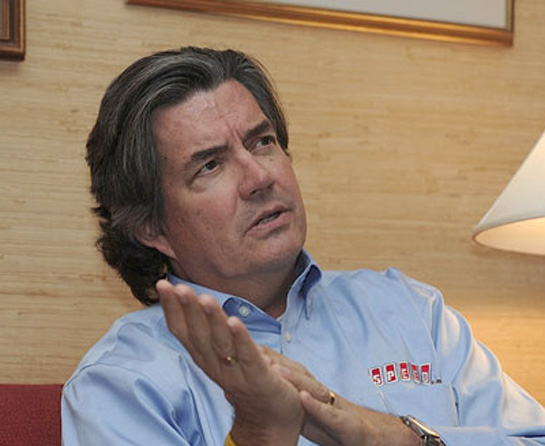
I don’t think you have a World Championship without an event in the United States. I think Bernie, in his heart of hearts, knows he needs to be in the United States. Credit Sidell Tilghman.
VeloceToday: Wouldn’t having a recently retired F1 driver add a special element to the team?
Possibly having a fresh perspective of F1 cars in there would be good, but more important than having a certain area of expertise is the ability to articulate a certain perspective. Eddie Cheever is one of the few drivers I’ve worked with who has anything like David’s ability to explain things in a way that viewers across the board can appreciate. I was really impressed with him the few times I worked with him. Derek Daly is another. He has a real respect for the spectator’s point of view of racing. Eddie calls the Indy 500 for ABC, of course.
VeloceToday: What about Scott Speed?
When we first became aware of Scott, of course he was actively driving and only recently was he free to do other things. I don’t do the hiring, but for whatever reason, things didn’t work out between Scott and SPEED; but that doesn’t mean it might not happen down the road.
VeloceToday: We miss Peter Windsor. Where is he?
He spends most of his time in London, where he does an internet broadband program and interviews the F1 drivers (theracedriver.com). I know he’s done Mark Webber and Pedro de la Rosa. He’d like to return to SPEED, and we are working on some options. Will Buxton has the contract— and I like Will and think he’s doing a good job—so we’ll have to see where Peter could fit. Knowing Peter’s compulsion with being at the races, I think he’d like to be on the ground.
VeloceToday: What do you think about F1 coming to United States?
I don’t think you have a World Championship without an event in the United States. I think Bernie, in his heart of hearts, knows he needs to be in the United States. Norbert Haug of Mercedes Benz says, “We don’t want a race in the U.S, we want two or three of them!” I hope that Austin [Texas] succeeds, and there are rumors out there that there are people who are attempting to get Bernie’s attention with regard to another GP here. But perhaps after the experience with US F1, we are all pretty skeptical now.
VeloceToday: What about the proposed F1 event in Austin, Texas?I am not immersed in the progress at Austin, but I have spoken to a lot of credible people. I was skeptical about Austin when it was first announced. Now it seems that there is real money behind the project as well as the backing of the Texas government. Time may be the big concern, but anything is possible.
VeloceToday: What can you say about the dominance of NASCAR coverage?
I understand the complaints, but I also think it’s good to see NASCAR succeed because the rising numbers of viewers increase interest in racing in general. If it helps more people to pay attention to motorsports overall, that is to the good. If new fans come and say, “NASCAR’s not quite right for me, but I like what I’m seeing, but where else can I go for my money…”, then you’ve got more support for sports car racing, Indy racing and Formula 1.
VeloceToday: Who will be the 2011 World Champion?
I think that it may be easier this year for Vettel to beat Webber, who is always capable of great things. Ferrari looked good at Valencia, the Renault looks very advanced, and a now that Heidfeld is there he may increase Renault’s chances in Kubica’s absence. The McLaren looks radical too, and I think it will be interesting to see how Jenson Button does; he’s a master with tires. For the last four years we’ve had a golden era in F1; the championship has gone down to the last race nearly every year. It’s really hard to call.
In Part II, Varsha discusses why SPEED can’t create the kind of programming many of us would like, and talks about his favorite drivers and experiences.
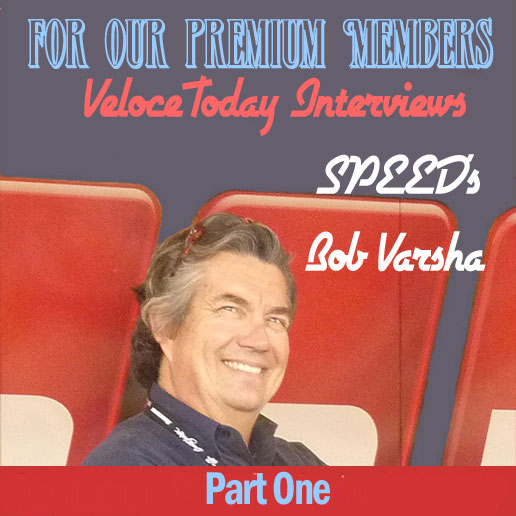
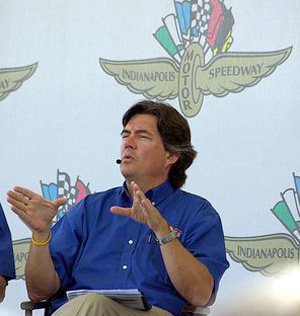
Having worked with Bob at Laguna Seca’s Historics, and having on occasion emailed him about one or other aspects of F1, it is no surprise that this interview captures the intelligence, good sense and informed sensibility he brings to his SPEED broadcasting. He is unfailingly kind and helpful, among the very best in the business. The Varsha-Hobbs-Matchett team does an excellent job given the constraints that viewers could hardly imagine (commercial breaks, timing of track activities, etc.). Though I have been watching F1 for decades, at the tracks and on television, I always leave a Varsha-Hobb-Matchett broadcast better informed both from an action and historical perspective.
Thank you for the nice interview. I was wondering how it all happens so well.
I like all the players and especially like Sam Posey’s lead-ins. Mr. Hobbs “Clag” and “Schlomozzle” comments are great. I think I heard him use those words at Siebkens at Elkart lake, WI, he will tell you what a fun palce that is!! Mr.
Varsha keeps them all on the same page.
US Grand Prix:
I worked the Road America track for SCCA and have walked it many times and done lots of laps there in my Alfa GTV. From a driver’s (OK neophite) perspective, I think Road America is the best place in the US to run a GP event.
Sadly I remember Bernie E. desparaging the idea as it is not in a “Glitz” area.
The area can handle a crowd as they put on the anual EAA flying event 30 miles away and that has hunderds of thousands for attendance. Road America draws big and would be a great venue at a “Real” racetrack liek SPA. A Wisconsin
“Cheeshead” GP would draw for the whole midwest. Left up to Bernie though it will never happen.
Keep up the great coverage. My vote for a US GP is Road America hands down.
Please pass my thanks on to the GP coverage crew.
Thank you for the opportunity to make a comment.
Veloce Today is great, but then I drive a 1966 Giulia Sprint GT Veloce so am biased!
Mike Juneau
268 Springfield Road
Newport, NH 03773
mjuneau@admix.com
commentary of the right sort can really help a sports broadcast–is there any way we can get Dennis Miller interested in F1?
Toly —
Anything for you. How about Dennis Miller, Sam Posey, Bobby Unser, Bob Varsha, and you in the booth? Each broadcast begins with a coin toss; loser has to wear the Referee’s shirt.
I’ll get right to work on it . . . .
David
Yes, Bob Varsha is the best current commentator on the F1 scene. Now if we could have Murray Walker in addition,it would be the best of all possible worlds.
I lived and worked in the UK when Murray Walker was at his prime.
Jerry Lehrer
Looking forward to part 2. As one of the many disappointed sports car racing fans that missed TV coverage of Sebring I’m not sure I understand how viewers who say, “NASCAR’s not quite right for me, but I like what I’m seeing, but where else can I go for my money…”, then you’ve got more support for sports car racing, Indy racing and Formula 1.” can happen if there is no TV coverage of an important race like Sebring. And this comment is from someone that has attended over 25 NASCAR Cup races.
Dave Seibert provided readers with a nifty deep peak at one of the characters who comprise the rock bed of TV Motorsports journalism. As Speed TV probably goes to 50 million households in the U.S., he is a personality who is much discussed. It always tweaks me to hear viewers tell me what they think he should say, but listening to that is part of this business, I guess. Perhaps unknow to a few, is the enormous intellect, and mental versatility of Varsha. Having done around twenty shows with Bob, I was always respectfully amazed he could take the show opening script, for example, spend 15 minutes reading it, then voice our work on camera… perfectly. The usually tough second take “just for back up” came out the same way. As he walked the set, always studded with great cars, he would hit his marks with the exact same word as the previous take. How in the world can you explain that? A talent from heaven ? And if you gave him a chance he could improve your written dialogue. Spontaneous, intuitive, creative, skillful, and charismatic. Thanks Seibert. Astute interview.Thanks Bob Varsha
I am a big fan of the Speed F1 coverage, especially Bob Varsha, I love the whole team, do miss Peter Windsor a bit.
Looking forward to another great Season,
Mark Swasey